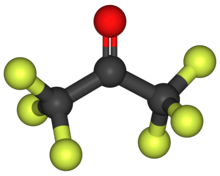| Revision as of 11:43, 9 August 2011 editCheMoBot (talk | contribs)Bots141,565 edits Updating {{chembox}} (no changed fields - added verified revid - updated 'DrugBank_Ref', 'UNII_Ref', 'ChEMBL_Ref', 'ChEBI_Ref', 'KEGG_Ref') per Chem/Drugbox validation (report [[Wikipedia_talk:Wi← Previous edit | Revision as of 02:33, 16 August 2011 edit undoChris Capoccia (talk | contribs)Extended confirmed users86,557 editsNo edit summaryNext edit → | ||
| Line 63: | Line 63: | ||
| ==Reactivity== | ==Reactivity== | ||
| Hexafluoroacetone is a reactive substance, acting primarily as an ]. In water hexafluoroacetone is highly reactive as its ] sharply favors (~10<sup>6</sup>) forming a ]-] ], unlike the identical unfavorable equilibrium with acetone (10<sup>-3</sup>).<ref name="Lemal2004"> |
Hexafluoroacetone is a reactive substance, acting primarily as an ]. In water hexafluoroacetone is highly reactive as its ] sharply favors (~10<sup>6</sup>) forming a ]-] ], unlike the identical unfavorable equilibrium with acetone (10<sup>-3</sup>).<ref name="Lemal2004">{{cite journal |doi=10.1021/jo0302556}}</ref> This makes the equilibria of two chemicals differ by about a ''billion'' regarding this addition of water.<ref name="Lemal2004"/> Hexafluoroacetone-hydrates are acidic and react with most metals to generate ]. Hexafluoroacetone violently reacts in the presence of alkali. Related to its tendency to hydrate, (CF<sub>3</sub>)<sub>2</sub>CO adds ] to give (CF<sub>3</sub>)<sub>2</sub>C(OH)(NH<sub>2</sub>) which can be dehydrated with ] to give (CF<sub>3</sub>)<sub>2</sub>CNH.<ref>{{OrgSynth | author = Middleton, W. J.; Carlson, H. D. | title = Hexafluoroacetoneimine | collvol = 6 | collvolpages = 664 | year = 1988 | prep = CV6P0664}}</ref> | ||
| ==References== | ==References== | ||
Revision as of 02:33, 16 August 2011
 | |
 | |
| Names | |
|---|---|
| IUPAC names
1,1,1,3,3,3-hexafluoro- 2-propanone | |
| Other names
perfluoroacetone acetone hexafluoride perfluoro-2-propanone | |
| Identifiers | |
| CAS Number | |
| 3D model (JSmol) | |
| ChEBI | |
| ChemSpider | |
| ECHA InfoCard | 100.010.616 |
| RTECS number |
|
| CompTox Dashboard (EPA) | |
InChI
| |
SMILES
| |
| Properties | |
| Chemical formula | C3F6O |
| Molar mass | 166.02 g/mol |
| Appearance | Colorless gas |
| Density | 1.32 g/ml, liquid |
| Melting point | −129 °C (144 K) |
| Boiling point | −28 °C (245 K) |
| Solubility in water | Reacts with water |
| Hazards | |
| Occupational safety and health (OHS/OSH): | |
| Main hazards | Toxic (T), Corrosive (C) |
| NFPA 704 (fire diamond) |
 |
| Flash point | N/A |
| Related compounds | |
| Except where otherwise noted, data are given for materials in their standard state (at 25 °C , 100 kPa).
| |
Hexafluoroacetone is a chemical compound with the formula CF3-CO-CF3. It is structurally similar to acetone, however its reactivity is markedly different. It comes in the form of a colourless, hygroscopic, nonflammable, highly reactive gas characterized by a musty odour. The most common form of this substance is hexafluoroacetone sesquihydrate (1.5 H2O), which is a gem-diol.
Synthesis and reactions
(CF3)2CO is prepared in a two step process from perfluoropropene. In the first step KF catalyzes the reaction of the alkene with elemental sulfur to give the 1,3-dithete 2. This species is then oxidized by iodate to give (CF3)2CO.
Uses
Hexafluoroacetone is mostly employed in organic synthesis, but it is also the main chemical intermediate used in the production of hexafluoroisopropanol, as well as polymethyl methacrylates and polyesters for textile coating. Hexafluoroacetone can be employed as a solvent for acetal resins, polyamides, polyglycolide, polyacetals and polyols or as a polymer adhesive.
Reactivity
Hexafluoroacetone is a reactive substance, acting primarily as an electrophile. In water hexafluoroacetone is highly reactive as its equilibrium sharply favors (~10) forming a gem-diol hydrate, unlike the identical unfavorable equilibrium with acetone (10). This makes the equilibria of two chemicals differ by about a billion regarding this addition of water. Hexafluoroacetone-hydrates are acidic and react with most metals to generate hydrogen. Hexafluoroacetone violently reacts in the presence of alkali. Related to its tendency to hydrate, (CF3)2CO adds ammonia to give (CF3)2C(OH)(NH2) which can be dehydrated with phosphoryl chloride to give (CF3)2CNH.
References
- Van Der Puy, M. ; Anello, L. G. (1990). "Hexafluoroacetone". Organic Syntheses
{{cite journal}}: CS1 maint: multiple names: authors list (link); Collected Volumes, vol. 7, p. 251. - ^ . doi:10.1021/jo0302556.
{{cite journal}}: Cite journal requires|journal=(help); Missing or empty|title=(help) - Middleton, W. J.; Carlson, H. D. (1988). "Hexafluoroacetoneimine". Organic Syntheses
{{cite journal}}: CS1 maint: multiple names: authors list (link); Collected Volumes, vol. 6, p. 664.